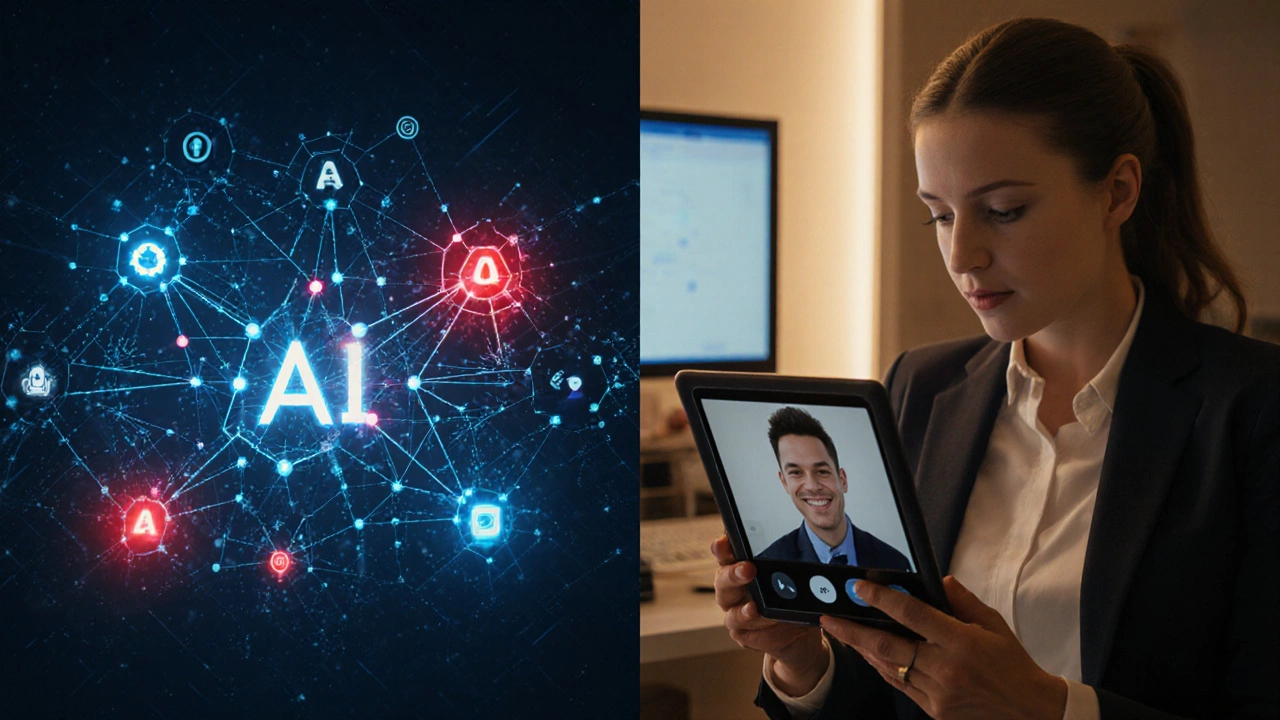Can AI Replace Banking? Here’s What’s Really Happening Today
 Nov, 15 2025
Nov, 15 2025
AI Loan Decision Simulator
Key Insight: AI considers 70+ data points beyond credit score including spending habits and employment stability. Your consistent savings pattern significantly boosted your approval chances.
Key Insight: Human reviewers might focus more on the credit score (720) but could miss your strong savings history. They're also more likely to see the 3-year employment stability as borderline.
When you open your banking app and see a chatbot answer your question in under five seconds, or when your loan gets approved before you finish your coffee, it’s hard not to wonder: Can AI replace banking? The short answer? Not the whole thing - but it’s already replacing most of the parts you never noticed.
AI isn’t sitting in a cubicle - it’s running the backend
Most people think of AI in banking as chatbots or voice assistants. That’s the surface. Underneath, AI is handling 70% of routine transactions at major banks like JPMorgan Chase and Bank of America. It reviews loan applications, flags fraud in real time, and even predicts which customers are likely to close their accounts - before they even think about it. Take fraud detection. In 2024, AI systems at global banks blocked $28 billion in fraudulent transactions. That’s not just better than humans - it’s 12 times faster. A human analyst might spot a suspicious $5,000 transfer after a day of digging. An AI model catches 47 similar patterns across 3 million transactions in 0.3 seconds. And it doesn’t need coffee breaks.Loans? AI decides more than you think
If you applied for a personal loan in the last two years, there’s a good chance an algorithm made the final call. Banks like Wells Fargo and Capital One now use machine learning models trained on decades of repayment data, income trends, spending habits, and even utility bill payments. These models don’t just look at your credit score. They see how often you pay rent on time, whether you’ve changed jobs frequently, and if your grocery spending dropped after a medical bill. One study from the Federal Reserve in 2024 found that AI-driven loan approvals had a 15% lower default rate than human-reviewed ones. Why? Humans get tired. They get biased. They focus on the one red flag - a past bankruptcy - and ignore the bigger picture: the person’s income has doubled since then. AI doesn’t care about your resume. It cares about your behavior. And it’s learning from millions of data points every day.Customer service bots aren’t the future - they’re the present
You’ve probably talked to a bank chatbot. Maybe you asked about your balance. Maybe you asked how to reset your PIN. That’s fine. But now, those bots handle 80% of all customer service inquiries - and they’re getting smarter. HSBC’s AI assistant, Olivia, doesn’t just answer questions. It remembers your past interactions. If you asked about overdraft fees last week and now you’re asking about savings accounts, it connects the dots. It can suggest a high-yield savings plan based on your spending patterns. It doesn’t push products. It offers options - and tracks which ones you actually use. And here’s the twist: customers prefer talking to bots for simple issues. A 2025 survey by McKinsey found that 68% of users under 40 would rather use an AI assistant than wait on hold for a human. For complex problems - like disputing a charge or applying for a mortgage - they still want a person. But the AI handles the prep work. It gathers documents, checks eligibility, and even drafts your message. The human just signs off.
What AI can’t do - and why humans still matter
AI doesn’t understand grief. If you lost your job and your account is overdrawn, no algorithm can say, “I’m sorry. Let’s figure this out together.” Banks still need human advisors for high-stakes situations: divorce settlements, inheritance planning, small business crises. These aren’t just financial decisions - they’re emotional ones. AI can crunch numbers on a divorce settlement, but it can’t sense when someone is too overwhelmed to make a choice. Also, regulators still require human oversight. In the U.S., the OCC (Office of the Comptroller of the Currency) requires that every automated loan decision be reviewable by a human. In the EU, the AI Act mandates that customers be told when an algorithm made a decision that affects them - and they have the right to appeal to a person. So AI doesn’t replace bankers. It makes them better. The banker of 2025 isn’t someone who memorizes interest rates. They’re someone who interprets AI insights, builds trust, and handles the messy human parts.The real threat isn’t AI - it’s outdated systems
Many banks still run on 30-year-old software. That’s why fintechs like Chime, Revolut, and N26 are eating their lunch. These companies didn’t build AI on top of broken systems. They built AI into their core from day one. Revolut, for example, uses AI to auto-adjust your budget categories based on your spending. If you start buying more gym memberships, it notices. If you’re traveling to Japan, it pre-loads local currency and warns you about exchange fees. It doesn’t wait for you to ask. It anticipates. Traditional banks are playing catch-up. They’re spending billions to modernize. But legacy systems are like old houses - you can paint the walls, but the pipes still leak.